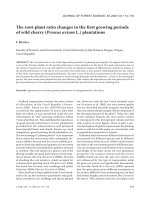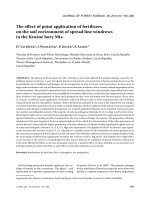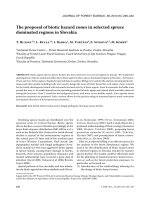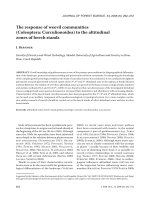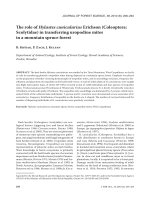Báo cáo lâm nghiệp: "The survey of some factors affecting bark lesion development caused by Phytophthora cactorum on common beech and other broadleaved trees" pdf
Bạn đang xem bản rút gọn của tài liệu. Xem và tải ngay bản đầy đủ của tài liệu tại đây (345.18 KB, 8 trang )
J. FOR. SCI., 56, 2010 (3): 93–100 93
JOURNAL OF FOREST SCIENCE, 56, 2010 (3): 93–100
Phytophthora cactorum (Lebert & Cohn) J.
Schröt is the dangerous pathogen of some broad-
leaved tree species belonging to genera Acer, Aes-
culus, Castanea, Fagus, Fraxinus, Juglans, Prunus,
Pyrus, Quercus, Salix, Ulmus etc. and many or-
namentals including Rhododendron spp. (E,
R 1996). Especially, P. cactorum has been
known as a cause of damping-off disease in beech
seedlings in several European countries (E,
R 1996). The small-scale nursery survey in
Germany revealed that beech fields are regularly
infested with P. cactorum (J et al. 2005). On
the other hand, the pathogen causes collar and
stem lesions of beech and other woody plants.
The disease severity has arised in some European
countries recently (e.g. J et al. 2005; B,
J 2006).
e damping-off disease in beech seedlings was
repeatedly mentioned in the Czech Republic (e.g.
J 2003 and many others). e diseases of
ornamentals caused by P. cactorum were reported
in the area as well (e.g. NN
1949; C 1961). However no extensive investiga-
tion of Phytophthora species (including P. cactorum)
on forest tree species has been carried out in the
Czech Republic yet. We have found neither precise
Supported by the Ministry of Agriculture of the Czech Republic, Project No. QH71273.
e survey of some factors affecting bark lesion
development caused by Phytophthora cactorum
on common beech and other broadleaved trees
V. H, K. Č, V. S, M. M, B. G,
Š. G
Silva Tarouca Research Institute for Landscape and Ornamental Gardening, Průhonice,
Czech Republic
ABSTRACT: e three experiments relating to the pathogenicity of Phytophthora cactorum to beech and other forest
tree species were carried out. e experiments were aimed to confirm pathogenicity of the pathogen, to compare its
pathogenicity with the other Phytophthora species isolated from woody plants in the Czech Republic (P. gonapodyides,
P. cambivora, P. citricola s.l., P. cinnamomi, P. citrophthora), to confirm its substrate specificity and diverse pathogenicity
to common forest tree species (common beech, pedunculate oak, sycamore, small-leaved lime, black alder, common
ash) and to determine the influence of excessive watering on the stem canker development. We found out that the tested
isolate of P. cactorum was more effective to the host than isolates of P. gonapodyides and P. cambivora. e isolates of
P. cinnamomi and P. citrophthora caused the largest necroses. It emerged that all tested tree species were susceptible
to P. cactorum. e most susceptible tree species were sycamore and common beech. e most resistant tree species
were common ash and pedunculate oak. e existence of substrate specificity of the pathogen was unequivocally con-
firmed. It was found out that the water stress could play an important role in the bark lesion development. We found
out important differences in lesion development in different periods during growing season (June, September).
Keywords: artificial infection; bark lesion; broadleaved trees pathogenicity; common beech; Fagus sylvatica; Phyto-
phthora cactorum; substrate specificity; water stress
94 J. FOR. SCI., 56, 2010 (3): 93–100
pathogen description in Czech contemporary phy-
topathological literature nor an isolate deposited in
any Czech culture collection yet. e morphological
similarity of many Phytophthora species (includ-
ing P. cactorum) is well-known. us some Czech
reports of P. cactorum without clear confirmation
of the pathogen identity should be regarded with
some caution.
e first authentic isolates of Phytophthora cac-
torum were acquired during the contemporary
investigation of phytophthora diseases of forest
and ornamental woody plants from beech, white
poplar, horse chestnut and rhododendron (M-
et al. 2008; C et al. 2009). Although the
investigations leading to definition of the host spec-
trum and to decription of the pathogen variability
in the Czech Republic have still been in progress,
we started the experiments concerned with the
pathogenicity of P. cactorum to forest tree species.
ese experiments were aimed to compare patho-
genicity of P. cactorum with another Phytophthora
species isolated from woody plants in the Czech
Republic (P. gonapodyides, P. cambivora, P. citri-
cola s.l., P. cinnamomi, P. citrophthora), to confirm
the pathogenicity of P. cactorum to common forest
tree species (common beech, pedunculate oak,
sycamore, small-leaved lime, black alder, common
ash), to detect potential substrate specificity within
P. cactorum
, and to verify the effect of water stress
on the stem lesion development caused by P. cacto-
rum. e article deals with the outcomes of these
first infection experiments.
MATERIAL AND METHODS
Phytophthora isolates used in the study
e Phytophthora isolates used in the study were
acquired in 2006 and 2007 from different regions in
Bohemia. e isolates of P. cactorum were acquired
from stem lesions of white poplar, common beech
and horse chestnut. e identity of the isolates was
verified by morphological analysis as well as by the
analysis of the ITS regions (C et al. 2009). P. cac-
torum isolates are deposited in the Silva Tarouca
Research Institute for Landscape and Ornamental
Gardening (RILOG) culture collection, Culture Col-
lection of Fungi (Prague) and their sequencies in
GenBank. e P. cactorum isolates used in the study:
P066.07 (isolated from white poplar, CCF Acc.
No. 3757, GenBank Acc. No. EU562207), P078.07
(common beech, CCF 3768, GenBank EU638290)
and P100.07 (horse chestnut, CCF 3762, GenBank
EU562209). e short morphological description
of the species was given in C et al. (2009). e
isolates of the other Phytophthora species used in
the experiments are deposited in RILOG culture
collection and four of them in Culture Collection of
Fungi (CCF), Prague. eir identity was confirmed
by morphological analysis as well as by the analysis
of the ITS regions (M et al. 2007, M-
et al. 2008; Č et al. 2008). e isolates used
in the study are P. gonapodyides isolate No. P002.06
(isolated from stem lesion of red oak, CCF Acc. No.
3681, GenBank Acc. No. EF194774), P. cambivora
P020.06 (stem lesion of sweet chestnut, CCF 3682,
GenBank EF194777), P. citricola s.l. P159.07 (root
rot of pedunculate oak), P. citrophthora P081.07
(leaf spot of rhododendron, CCF 3768, GenBank
EU638290), and P. cinnamomi P107.07 (collar rot
of rhododendron, CCF 3763, GenBank EU562211).
J and B (2009) revealed this year that
P. citricola
composed from group of very close taxa
(P. plurivora, P. multivora, P. citricola group I, and
P. citricola
s.s.). Because of the unclear identity of
the Czech population of this pathogen, we use in
this article the name P. citricola s.l.
Plant material
In the experiment we used the 2/3-year old sap-
lings (height 40–60 cm) of common beech, pedun-
culate oak, sycamore, small-leaved lime, black alder,
and common ash. e saplings were potted at the
end of March 2007 into 18 × 18 cm plastic contain-
ers filled with sterile peat substrate (pH 5). en
the saplings were cultivated in hotbed until they
came into leaf. During the course of own experi-
ments the saplings were cultivated in greenhouse
at temperature ca 23–25°C, air humidity 40–60%
and watered with tap water if needed. All the three
infection experiments took 4 weeks; the plants were
randomized.
Infection experiments
Infection experiment I. Comparison of Phyto-
phthora spp. pathogenicity to common beech.
e tested Phytophthora species were: P. cactorum
(isolate No. P078.07), P. gonapodyides (P002.06),
P. cambivora
(P020.06), P. citricola s.l. (P159.07), P. cit-
rophthora (P081.07), and P. cinnamomi (P107.07).
ere were used 2-year old saplings of common beech
in the experiment. e stems of all saplings were
surface sterilized with 95% ethanol. ere were made
injuries with a cork borer (5 mm diameter) about 5 cm
above the collar. e agar plugs (5 mm diameter) from
actively growing colony margin were placed in the
J. FOR. SCI., 56, 2010 (3): 93–100 95
Species Mean (± SE)
P. gonapodyides 13.17 (± 0.71)
a
P. cambivora 16.17 (± 2.21)
a
P. cactorum 25.67 (± 2.70)
b
P. citricola s.l. 28.00 (± 1.40)
bc
P. citrophthora 37.25 (± 7.31)
bc
P. cinnamomi 40.67 (± 4.41)
c
SE – standard error
Table 1. Length of bark lesions caused by different
Phytophthora species on common beech saplings after
4 weeks. Values marked by the same letter (
a, b, c
)
are not
statistically different
injuries and sealed with Parafilm. e control plants
were treated in the same manner with sterile agar
plugs. ere were 20 plants in each infection treat-
ment and in the control group, too. e length of all
lesions was measured at the end of the experiment.
e experiment was carried out in June 2008.
Infection experiment II. Confirmation of sub-
strate specificity in P. cactorum.
ere were tested three P. cactorum isolates Nos
P066.07, P078.07, P100.07 we had acquired from
different hosts in different locations in the Czech
Republic. ere were used 3-year old saplings of com-
mon beech, pedunculate oak, sycamore, small-leaved
lime, black alder, and common ash (15 plants in each
isolate/host combination and in control groups). e
inoculation process was the same as described before.
e experiment was carried out in June, too.
Infection experiment III. Confirmation of water
stress effect on lesion development.
e P. cactorum isolate No. P078.07 and 2-year
old saplings of common beech were used in the ex-
periment. e inoculation process was the same as
described above. e first group (15 saplings) was
artificially infected by the isolate of P. cactorum.
e second one (15 saplings) was inoculated and
waterlogged and put in trays. e stable water level
in containers was kept ca 3 cm above the bottoms.
e experiment was carried out in September.
e application of the identical isolate (P078.08)
in all three experiments and the same inoculation
and cultivation technique allowed us to compare
the infection development between two periods
during the growing season: June (the first and sec-
ond experiments) and September (non-waterlogged
treatment in the third experiment).
Statistical evaluation
e length of stem necroses in all three experi-
ments was measured after 4 weeks. Statistical evalu-
ation was done by means of the statistical package
STATISTICA 8.0 (StatSoft Inc.). e variability in
measured data was too high, so we transformed
them by common logarithm. en the assumptions
of normality and homogeneity were tested. The
assumption of normality was fullfilled in all three
experiments. e Levene’s tests of homogeneity
of variances remained positive (P < 0.01), however
the share of maximal and minimal standard devia-
tions (SD) in length of lesions in particular groups
of plants was relatively low (max
SDi
/min
SDi
< 3)
and enabled the processing of the first and second
Fig. 1. Bark lesions caused by different Phytophthora species on common beech saplings after four weeks. From left to right:
control, P. gonapodyides, P. cambivora, P. cactorum, P. citricola s.l., P. citrophthora, P. cinnamomi
96 J. FOR. SCI., 56, 2010 (3): 93–100
experiments by means of ANOVA (H 2006).
The third experiment was assessed with use of
t-test with separate variance estimates. e differ-
ences in lesion length between June and September
was assessed with non-parametric Mann-Whitney
U test.
RESULTS
Infection experiment I. Comparison of Phyto-
phthora spp. pathogenicity to common beech.
The analysis of variance showed, that the com-
mon logarithm of lesion length was statistically in-
fluenced by factor Phytophthora species (SS = 2.18,
df = 5, MS = 0.44,
F = 17.53, P << 0.01). e post-hoc
comparisons (Tukey’s test) showed important differ-
ences among studied Phytophthora isolates (Table 1).
Isolate of P. gonapodyides was the least aggressive
(mean of lesion length was 13.17 mm), the most ag-
gressive was the P. cinnamomi isolate (mean 40.67 mm)
(Fig. 1).
P. cactorum isolate (mean 25.67 mm) was
moderately pathogenic. e length of lesions caused
by P. cactorum was statistically different from those
caused by P. gonapodyides and P. cambivora isolates on
one hand and from the most aggressive P. cinnamomi
isolate on the other hand (Table 1).
Infection experiment II. Confirmation of sub-
strate specificity in P. cactorum.
e analysis showed, that the lesion length in the
experiment was influenced by host species and by
interaction of host species and isolate identity, too.
e effect of the host species and the interaction was
statistically highly conclusive (P < 0.000). e effect
of isolate per se was not proved (Table 2).
The differences in susceptibility to the pathogen
among host species were evident from the first
view (Table 3, Fig. 2). The most susceptible host
species to the pathogen inoculation was sycamore
(mean of lesion 48.16 mm; P < 0.05) and the sec-
ond one was beech (mean of lesion 22.07 mm).
The differences among lesion extent on beech,
alder and lime were distinct, but not statistically
significant. The statistically (P < 0.05) most resis-
tant hosts were ash (mean of lesion 5.07 mm) and
oak (4.53 mm). When the effect of interaction host
and isolate was evaluated (i.e. host specificity), it
showed that the isolate P066.07 was significantly
more aggressive in oak (mean of lesion 9.87 mm)
than the other two isolates (2.47 and 1.27 mm).
The post-hoc test showed significant differences
among lesions caused by different isolates in
hosts and potentially complicated pattern of the
substrate specificity (Table 3). All the three tested
isolates were aggressive towards sycamore, beech
and alder in similar pattern (the most aggressive
was the P078.08 isolate acquired from beech, the
least agressive one was the P066.07 from poplar).
The susceptibility of lime to particular isolates
was nearly equal (Table 3, Fig. 2). The pattern of
aggressivity in ash was rather different – the more
aggressive was the isolate P100.08 compared to
P066.08 (P < 0.05). The most aggressive isolate in
oak (in comparison to both others) was P066.07
(P < 0.05).
Infection experiment III. Confirmation of water
stress effect on lesion development.
e experiment showed unequivocal change in
lesion length in the water-stressed treatment. e
stem necroses on plants subjected to water stress
were more extended than those on non-stressed ones
(P < 0.01). e mean of lesion length was 6.67 mm
in the non-stressed group and 18.67 mm in the
stressed one (Fig. 3).
Comparison of lesion development in two
different periods during growing season
e test (Mann-Whitney U test) showed, that the
lesion length was importantly different (P << 0.01)
between June and September (Fig. 4). e average
length of stem lesion in June was 26.88, and in Sep-
tember 6.73 mm only.
Source of variation SS df MS F P η
2
Host species 51.27 5 10.25 109.74 < 0.000 0.69
Isolate 0.27 2 0.14 1.45 0.24 0.01
Isolate – host species interaction 6.83 10 0.68 7.31 < 0.000 0.23
Error 23.17 248 0.09
Table 2. e effect of factors (host, isolate, interaction) on lesion length
SS – sum of squares. df – degrees of freedom. MS – mean square. F – F ratio. P – significance level. η
2
– ratio of explained
variability
J. FOR. SCI., 56, 2010 (3): 93–100 97
DISCUSSION
e variability in lesion length on particular hosts
and treatments in our experiments was relatively
high. is phenomenon occurred in other Phytoph-
thora infection experiments (i.e. J et al. 2005)
and it seemed to be common. e cause of the vari-
ation could be ascribed to the physiological status
of the host tissues, which could have a profound
influence on the apparent susceptibility of the plant
material to Phytophthora colonization as had sug-
gested M et al. (1988). e variation and
its negative effect on evaluation could be limited
with use of sufficient amount of saplings in experi-
ments. Furthermore it is necessary to use physi-
ologically uniform material and to make experiment
precisely.
e differences in Phytophthora species aggressive-
ness found out in our experiment resembled in ge-
neral features the differences which had been detected
in other experiments. Phytophthora gonapodyides is
soil species usually causing rot of root hair. e short
extent of stem lesion in the experiment was not sur-
prising – similar outcomes were obtained by J
et al. (2005). Phytophthora cambivora was regarded
as an aggressive species in other trials (T et
al. 2003; J et al. 2005) which caused more extent
lesions. e cause of difference could be ascribed to
the partial loss of pathogenic potential of our isolate
during its cultivation (it was acquired in 2006) or to
the variation in substrate specificity in P. cambivora.
e detected pathogenicity of P. cactorum resembled
the outcomes of J et al. (2005), T et al.
(2003, 2008) etc. We concluded that P. cactorum and
P. citricola s.l. could be very dangerous to common
beech and other woody plants in our nurseries, parks
and forests because they have commonly been iso-
lated in the Czech Republic recently (M et
al. 2007; M et al. 2008; C et al. 2008).
Phytophthora citrophthora and P. cinnamomi are
alien polyphagous invasive species from tropical zone
(E, R 1996). ese two species caused
Host Total mean of lesion (± SE) Isolate Mean of lesion (± SE)
A. pseudoplatanus 48.16 (± 5.38)
P066.07 33.53
(± 6.53)*
P078.07 58.93 (± 8.75)*
P100.07 52.00 (± 11.35)
F. sylvatica 22.07 (± 1.47)
a
P066.07 16.13 (± 2.24)*
P078.07 26.87 (± 2.27)*
P100.07 23.20 (± 2.46)
A. glutinosa 16.00 (± 1.07)
a
P066.07 17.00 (± 1.13)
P078.07 20.00 (± 2.28)*
P100.07 11.00 (± 1.18)*
T. cordata 13.90 (± 0.53)
a
P066.07 13.21 (± 1.00)
P078.07 14.69 (± 0.77)
P100.07 13.86 (± 0.99)
F. excelsior 5.07 (± 1.02)
b
P066.07 2.53 (± 0.96)*
P078.07 4.80 (± 1.59)
P100.07 7.87 (± 2.29)*
Q. robur 4.53 (± 0.91)
b
P066.07 9.87 (± 1.80)*
×
P078.07 2.47 (± 1.13)*
P100.07 1.27 (± 0.33)
×
Table 3. e extent of bark lesion caused by P. cactorum in host spectrum. Lesions in hosts followed by the same letter
(
a, b
second column) were not significantly different (two-way ANOVA, effect of host evaluated only, Tukey
s test;
P > 0.05). e lesion lengths caused by particular isolates in identical host (substrate specificity) followed by the same
character (*
,
×
fourth column) were statistically different (Duncan
s test; P ≤ 0.05)
98 J. FOR. SCI., 56, 2010 (3): 93–100
much more damage in our experiment than the oth-
ers. is finding is in agreement with the other infec-
tion experiments (B, J 2003; T
et al. 2008). e outcomes and extremely broad host
spectrum of the both species (E, R 1996;
F, R 2009) indicate, that Phytophthora
citrophthora and P. cinnamomi potentially pose a high
risk to our broadleaved forest trees.
The outcomes of our second experiment con-
firmed different sensitivity of the host species to
P. cactorum as well as the substrate specificity in
P. cactorum. Our outcomes are in agreement with
other authors. Pathogenicity experiments proved
by H et al. (2000) showed that P. cactorum
strains had a tendency towards host specialization.
e host specialization in P. cactorum was found by
T (2003) and B et al. (2006), too. e
difference in P. cactorum pathogenicity was found in
soil population (D et al. 1991) and in apple
trees population (B et al. 2006).
Our third experiment briefly confirmed the
causality between waterlogging stress and more
intensive stem lesion development. e reports of
this relation have not been published so far, but its
confirmation should be very important, because
dozens of Phytophthora disease events occurred
in water stress conditions or in environment with
high soil humidity. is result is in accordance with
general finding that stress of the host accelerates
disease development. Phytophthora diseases can be
accelerated by several stress factors – for instance
root and collar rot by water stress (waterlogging as
well as drought), wounding, low light intensity, high
temperatures, nitrogen content, soil compaction and
aeration, other diseases etc. (e.g. E, R
1996; B, H 2003; F et al.
2004), irrigation regime and technology (U
1999), environmental factors – microbial status of
substrate, pH of substrate, ground cover (E,
R 1996), manuring practice, soil tillage and
human mobility (F et al. 2004; M
et al. 2007) etc. erefore it is not surprising that
the stem lesion development can be accelerated by
waterlogging stress.
140
120
100
80
60
40
20
0
Lesion length (mm)
Sycamore Beech Alder Lime Ash Oak
Host
P066.07 (mean; mean ± SE)
P078.07
P100.07
range
outlier
Fig. 2. Extent of bark lesions caused by P. cactorum
isolates Nos P066.07, P078.07 and P100.07 on syca-
more, beech, alder, lime, ash and oak saplings
Fig. 3. Extent of bark lesions caused by P. cactorum
isolate P078.07 on beech saplings without water stress
(0) and with water stress (1)
mean
mean ± SE
range
outlier
60
50
40
30
20
10
0
Lesion length (mm)
0 1
Water stress
J. FOR. SCI., 56, 2010 (3): 93–100 99
e seasonal variation in the host (apple tree)
susceptibility to P. cactorum was demonstrated
by Z et al. (2007), who found that the host
susceptibility generally cycled to a low level during
dormancy in winter and to a high level during ac-
tive growth in summer. Similar pattern was found
in other studies in Phytophthora (e.g. R et al.
1994; B, K 2001). Possibly, the identi-
fied decrease in stem lesion length in September
could be connected with incoming period of host
dormancy.
Our results (M 2007; C et al. 2008,
2009; Č et al. 2008; M 2008; this
study) confirmed that Phytophthora spp. causing
diseases of woody plants should be taken more
seriously in the Czech Republic. e attention has
to be given not only to P. cactorum (relatively fre-
quently cited in the Czech Republic, see above) and
to quarantine species (P. ramorum, P. kernoviae) but
also to the other highly pathogenic species contem-
porary spreading in Europe (P. alni, P. cambivora,
P. cinnamomi, P. citricola s.l., P. citrophthora etc.).
Spreading of these Phytophthora spp. in the Czech
Republic represents high risk to our indigenous
broadleaved forest trees. Better familiarity with
Phytophthora species, appropriate cultivation of
plant material and sanitary practice are of great
importance to prevent potential substantial losses
in the future.
Re ference s
B Y., H E. (2003): Phytophthora species in
oak ecosystems in Turkey and their association with declin-
ing oak trees. Plant Pathology, 52: 694–702.
B R.G., C P.M., T T.H., A M.K.,
B G.T. (2006): Genetic and pathogenic variation
in Phytophthora cactorum affecting fruit and nut crops in
California. Plant Disease, 90: 161–169.
B N., M A., E M M. (2006):
Variability in pathogenicity among tunisian isolates of Phy-
tophthora cactorum as measured by their ability to cause
crown rot on four apple cultivars and MM106 roostock.
Journal of Agronomy, 5: 321–325.
B C.M., K S.A. (2001): Comparative aggressive-
ness of standard and variant hybrid alder phytophthoras,
Phytophthora cambivora and other Phytophthora species
on bark of Alnus, Quercus and other woody hosts. Plant
Pathology, 52: 218–229.
B C.M., J T. (2003): Progress in understanding
Phytophthora diseases of trees in Europe. In: MC
A.J., H G.E.S.J., T I. (eds): Phytophthora
in Forests and Natural Ecosystems. Perth, Murdoch Uni-
versity Print: 4–18.
B C.M., J T. (2006): Recent developments in Phy-
tophthora diseases of trees in natural ecosystems in Europe.
In: B C.M., J T. (eds): Progress in Research on
Phytophthora Diseases in Forest Trees. Farnham, Forest
Research: 5–16.
C K. 1961): Fungal diseases of dahlias. Česká mykologie,
15: 169–179. (in Czech)
C K., G B., S V., H V., T-
M., C M. (2008): Phytophthora alni
causing the decline of black and gray alders in the Czech
Republic. Plant Pathology, 57: 370.
Č K., G B., S V., T M.,
H V., G Š. (2008): Phytophthora cambivora
causing ink disease of sweet chestnut recorded in the Czech
Republic. Czech Mycology, 60: 267–276.
C K., S V., G B., H V.,
T M., M M., G S. (2009):
Phytophthora cactorum causing bleeding canker of com-
mon beech, horse chestnut, and white poplar in the Czech
Republic. Plant Pathology, 58: 394.
D T.W., O M.L., P J.L. 1991: Isolation
and pathogenicity of Phytophthora cactorum from forest
and ginseng garden soils in Wisconsin. Plant Disease, 75:
610–612.
Fig. 4. Extent of bark lesions caused by P. cactorum iso-
late P078.07 on beech saplings in June and September
mean
mean ± SE
range
outlier
50
40
30
20
10
0
Lesion length (mm)
June September
100 J. FOR. SCI., 56, 2010 (3): 93–100
E D.C., R O.K. (1996): Phytophthora Diseases
Worldwide. St. Paul, American Phytopathological Society
Press: 562.
F D.F., R A.Y. (2009): Fungal Databases, System-
atic Mycology and Microbiology Laboratory, ARS, USDA.
Available at (ac-
cessed May 4, 2009)
F T.F., A C.G., P B.R. (2004): Soil
compaction and ink chestnut disease. Forest Pathology,
34: 273–283.
H J., L A., N H., P P., W
S. (2000): Pathogenicity, morphology and genetic variation
of Phytophthora cactorum from strawberry, apple, rho-
dodendron, and silver birch. Mycological Research, 104:
1062–1068.
H J. 2006: Overview of Statistical Methods of Data
Processing: Analysis and Metaanalysis of Data. Praha, Por-
tál: 583. (in Czech)
J V. (2003): Contemporary health state of our
broadleaved woody plants. Zprávy lesnického výzkumu,
48: 109–111. (in Czech)
J T., B T.I. (2009): Re-evaluation of Phytophthora
citricola isolates from multiple woody hosts in Europe
and North America reveals a new species, Phytophthora
plurivora sp. nov. Persoonia, 22: 95–110.
J T., H W., J-T S.L., G H.M.,
F F., O W. (2005): Involvement of
Phytophthora species in the decline of European beech in
Europe and the USA. Mycologist, 19: 159–166.
M L., C J., M W., M C., A
C. (2007): Assessment of the spread of chestnut ink disease
using remote sensing and geostatistical methods. European
Journal of Plant Pathology, 119: 159–164.
M M.E., Y D.J., M C.J. (1988): Phyto-
phthora root rot and crown rot of apple trees in Arizona.
Plant Disease, 72: 481–484.
M M., C K., G S., T M.
2007): e first report of leaf spot, shoot blight, stem and
collar canker of Rhododendron spp. caused by Phytophthora
citricola in the Czech Republic. Plant Disease, 91: 1515.
M M., Č K., T M., G Š.
(2008): New Phytophthora species causing rhododendron
diseases in the Czech Republic. In: Woody Ornamentals of
the Temperate Zone. Průhonice, VÚKOZ: 100.
N-N H. (1949): ree quarters of year
of gardening work from point of view of phytopatho-
logist. Ochrana rostlin, 22: 238–256. (in Czech)
R C., D F., D-L M.L. 1994: Sea-
sonal changes in northern red oak susceptibility to Phyto-
phthora cinnamomi. Plant Disease, 78: 369–374.
T T. (2003): Variability in pathogenicity among
greek isolates of Phytophthora cactorum to four peach
rootstocks. Australian Journal of Experimental Agriculture,
43: 99–103.
T T., T C., C J. (2003): Pathogenic-
ity and relative virulence of 11 Greek Phytophthora species
on apple and pear rootstocks. New Zealand Journal of Crop
and Horticultural Science, 30: 261–264.
T T., K I., T C. (2008):
Susceptibility of thirty cherry genotypes on Phytophthora
cactorum, P. citrophthora, P. citricola and P. parasitica.
Journal of Phytopathology, 156: 446–451.
U R.S. (1999): Influence of drip, microjet and sprinkler
irrigation systems on the severity of crown and root rot of
M 26 apple rootstock trees in clay soil. Australasian Plant
Pathology, 28: 254–259.
Z P.T., D S., L I.F. (2007): Effect
of season and aggressiveness of isolates on the response of
two apple rootstocks to Phytophthora cactorum infection.
Australasian Plant Pathology, 36: 240–244.
Received for publication October 21, 2009
Accepted after corrections December 1, 2009
Corresponding author:
Mgr. V H, Výzkumný ústav Silva Taroucy pro krajinu a okrasné zahradnictví, v.v.i.,
Květnové náměstí 391, 252 43 Průhonice, Česká republika
tel.: + 420 296 528 235, fax: + 420 267 750 023, e-mail:




